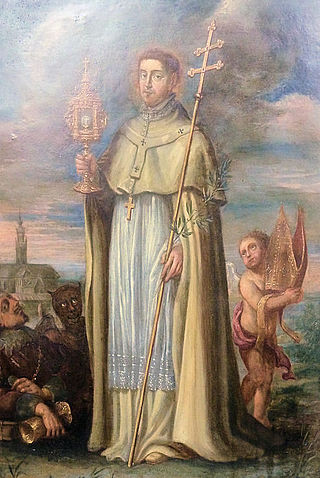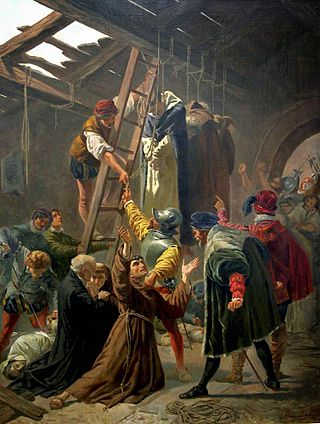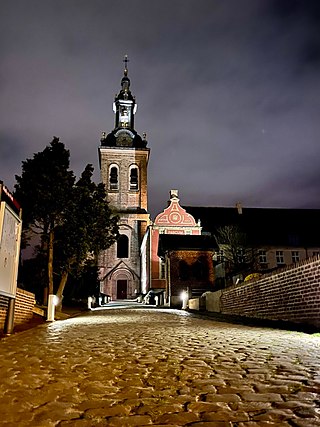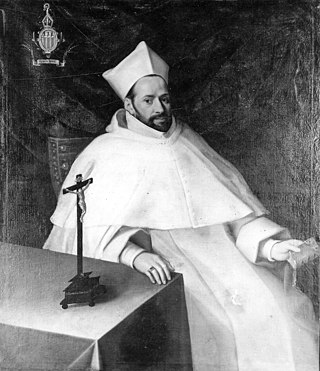Foundation
Berne Abbey was founded in 1134, the year of Norbert of Xanten's death, by the knight and nobleman Fulcold of Berne, lord of Teisterband, in the Dutch town of Berne, on the banks of the river Maas, two miles south-east of Heusden and about six miles north-west of 's-Hertogenbosch.
Numerous legends surround its foundation. One is that Fulcold, when hotly pressed in battle, made a vow to build an abbey, if, by throwing himself into the river Maas, his life might be preserved from the enemy. This prayer having been heard, Fulcold converted his castle at Berne into a monastery, where he himself became a lay brother. Blessed Fulcold died on April 12, 1149, on which day his name is recorded in the hagiology of the Premonstratensian order.
Fulcold initially brought Augustinian canons from Rolduc Abbey to Berne to start the monastery, but was dissatisfied with their lack of discipline, and sent them back again. He made another attempt at a foundation in 1134 with the newly established Premonstratensian Order, also called Norbertines after their founder Norbert of Xanten. From the nearby Mariënweerd Abbey an abbot and some canons were sent to his castle. This time Fulcold himself also joined the community. His wife, Bescela, also chose a religious life in Berne and later in the monastery of Altforst, a Norbertine nunnery linked to the abbey. The appointed guardians of the abbey were at first the dukes of Cleve. In 1248 the dukes of Brabant took over this duty and finally in 1399 the counts of Holland and the Dukes of Guelders.
Middle Ages till 1857
Berne Abbey has always been held in high esteem, as is proved by the privileges which were granted to it. It possessed the right of patronage over nine parishes, which were always served by priests from the abbey. In comparison with the contemporaneous monastic foundations in Germany and Belgium, Berne Abbey was relatively late to acquire these parishes. After a century of existence the monastery changed its direction. The strict monastic period ended and the focus shifted now from works in the monastery to work outside the abbey. Not only the secular authority, but also the spiritual authority of the abbey grew, making it a spiritual and secular center in this region of The Netherlands. Priests were sent to parishes and the parishes given to the abbey, often with all the additional rights. In this way the village of Berlicum came into the possession of Berne Abbey in 1240, and Heeswijk in 1284. In 1285 Oudheusden, Elshout, Hedikhuizen, Vlijmen and Engelen were added to them, and in 1369 Bokhoven, in 1613 Lithoyen, in 1846 Haarsteeg, and in 1948 Middelrode. Finally in 1964 the parish of Heikant-Quirijnstok in Tilburg was given into the care of abbey by the diocese of 's-Hertogenbosch. The villages of Dinther and Vorstenbosch are now also linked to the abbey.
In 1572, during the Eighty Years' War, the abbey was plundered by the Geuzen. On 25 September 1579, it was burned down. In 1648, when the Peace of Münster was signed, the abbey's last remaining estates were confiscated by the States of Holland.
The canons withdrew inside the thick city walls of 's-Hertogenbosch. After the siege of 's-Hertogenbosch in 1629 they sought shelter in the various parishes and in the safer southern part of the Netherlands. The religious were not discouraged, and the abbot obtained a house at Vilvoorde, near Brussels, from which he directed the spiritual and temporal interests of his dispersed community. Several of the priests of Berne, though compelled to remain in hiding and always in danger, continued to minister to the spiritual needs of their people, which may account for some parts of North Brabant and Gelderland remaining Roman Catholic. The future of the community was provided for by the admission of postulants, who made their novitiate and continued their studies at Vilvoorde or in one of the Belgian abbeys. In this way Berne Abbey has been kept up, while nearly all other monasteries, which had made no such provision, have died out in the Netherlands.
Though dispersed, the canons met frequently at Heeswijk or in some presbytery, and at the death of the abbot they always elected another, so that from the foundation of the abbey in 1134, there is an unbroken succession of abbots.
Heeswijk
At the end of the eighteenth century the French Republic confiscated the house at Vilvoorde and so put an end to the community's refuge in Belgium. But novices continued to be admitted, who had their time of probation and made their studies either at the house at Heeswijk or in some presbytery of the order.
King William I of the Netherlands confirmed the continued existence of the abbey in 1824, as did Pope Gregory XVI in 1832. The abbots lived mostly in Heeswijk, where they had a small castle. With the arrival of better times Abbot Neefs in 1847 enlarged it and inaugurated the community life.
In 1857 the abbey was finally located in Heeswijk and in 1879 a new abbey church was built, which was enlarged in 1927 by architect Hendrik Willem Valk with money donated by farmers after the death of the peasant apostle Gerlacus van den Elsen, to whom on the outside wall the sculptor Joseph Cantre cut a cornerstone of his portrait as a tribute. The architect Valk also designed the abbey gate. The new main building dates from 1999 and was designed by the architect Oomen. In 2006 the interior of the church was substantially changed by the realignment of the different floor levels on a single surface. The second organ was moved to the balcony. The pewa were removed and replaced by chairs. The church was painted in three shades of yellow and equipped with a new lighting system.
The community grew in numbers, and in 1886 the abbot opened a college, entirely staffed by priests from the abbey. The Gymnasium St. Norbert was established, and still exists today as the Gymnasium Bernrode. Around 1920 the abbey began production of their liturgical publications in their own printing office. By acting as publishers and booksellers their religious message was spread. Next to the abbey there is a still a printing office, a bookshop and a publishing group for Liturgy.

Norbert of Xanten, O. Praem (Gennep-Magdeburg), also known as Norbert Gennep, was Archbishop of Magdeburg, founder of the Premonstratensian order of canons regular, and is venerated as a saint in the Catholic Church. Norbert was canonized by Pope Gregory XIII in the year 1582, and his statue appears above the Piazza colonnade of St. Peter's Square in Rome.

The Order of Canons Regular of Prémontré, also known as the Premonstratensians, the Norbertines and, in Britain and Ireland, as the White Canons, is a religious order of canons regular of the Catholic Church founded in Prémontré near Laon in 1120 by Norbert of Xanten, who later became Archbishop of Magdeburg. Premonstratensians are designated by OPraem following their name.

Heeswijk is a Dutch village. It is located in the province of North Brabant, in the south of the Netherlands.

Beeleigh Abbey near Maldon in Essex, England, was a monastery constructed in 1180 for the Premonstratensians, as known as the Norbertines or Premonstratensians. The order linked the change of the separate life of monks in the 12th century with the retrospective life of the friar, who was considerably more active.

The Martyrs of Gorkum were a group of 19 Dutch Catholic clerics, secular and religious, who were hanged on 9 July 1572 in the town of Brielle by militant Dutch Calvinists during the 16th-century religious wars—specifically, the Dutch Revolt against Spanish rule, which developed into the Eighty Years' War.

Averbode Abbey is a Premonstratensian abbey situated in Averbode, in the municipality Scherpenheuvel-Zichem, in the Archdiocese of Mechelen-Brussels in Belgium. It was founded about 1134, suppressed in 1797, and reestablished in 1834. Throughout the 20th century the abbey press was a leading children's publisher in Belgium. The church's building is a peculiar synthesis of Baroque and Gothic, with Renaissance ornament details, dominating the monastery complex. The whole structure was built of iron sandstone from Langdorp and white sandstone from Gobertange between 1664 and 1672, after a design by the Antwerp architect Jan Van den Eynde II.

Tongerlo Abbey is a Premonstratensian monastery at Tongerlo in Westerlo near Antwerp, Belgium.

Postel Abbey is a Premonstratensian abbey in the Belgian municipality of Mol in the province of Antwerp.

Strahov Monastery is a Premonstratensian abbey founded in 1143 by Jindřich Zdík, Bishop John of Prague, and Vladislaus II, Duke of Bohemia. It is located in Strahov, Prague, Czech Republic.
Roggenburg Abbey is a Premonstratensian canonry in Roggenburg near Neu-Ulm, Bavaria, in operation between 1126 and 1802, and again from its re-foundation in 1986. Since 1992 it has been a dependent priory of Windberg Abbey in Lower Bavaria. The monastery manages a training centre and a museum, and is widely known for its almost unchanged Baroque building and the organ concerts that are held in the church.

Tupholme Abbey was a Premonstratensian abbey close to the River Witham some 10.5 miles (16.9 km) east of the city of Lincoln, England and one of nine such abbeys within the historical county. The Witham valley in Lincolnshire is notable for its high concentration of monasteries—there were six on the east bank and three on the west—all presumably drawn to the area by the usefulness of the River Witham for transport and by the wealth that it transported. The abbey was largely destroyed by 1538, after being seized during Henry VIII's Dissolution of the Monasteries.

Windberg Abbey is a Premonstratensian monastery in Windberg in Lower Bavaria, Germany.

Rot an der Rot Abbey was a Premonstratensian monastery in Rot an der Rot in Upper Swabia, Baden-Württemberg, Germany. It was the first Premonstratensian monastery in the whole of Swabia. The imposing structure of the former monastery is situated on a hill between the valleys of the rivers Rot and Haslach. The monastery church, dedicated to St Verena, and the convent buildings are an important part of the Upper Swabian Baroque Route. Apart from the actual monastic buildings, a number of other structures have been preserved among which are the gates and the economy building.

Park Abbey is a Premonstratensian abbey in Belgium, at Heverlee just south of Leuven, in Flemish Brabant.

Bonne-Espérance Abbey was a Premonstratensian abbey that existed from 1130 to the end of the 18th century, located in Vellereille-les-Brayeux in the Walloon municipality of Estinnes, province of Hainaut, Diocese of Tournai, in present-day Belgium.

Jan Druys, Latinized Drusius (1568-1634) was a Norbertine canon regular from the Low Countries who became the 30th Abbot of Park Abbey in Heverlee just outside Leuven.

Frigolet Abbey is a grand Premonstratensian monastery complex in Southern France. It is located in the territorial commune of Tarascon, in the region of the Montagnette, the parishes of which are served by the canons of the monastery. It was originally associated with the Order of Saint Benedict.

St. Norbert Abbey is a Roman Catholic monastery of Canons Regular of Premontre, located in De Pere, Wisconsin. The Abbey is named after Saint Norbert of Xanten, the founder of the order, after whom, members are known as, "Norbertines". St. Norbert Abbey was established in 1898 by Norbertines from Berne Abbey in the Netherlands. St. Norbert's is the oldest religious community of its kind in the United States, serving as the Mother Canonry to Norbertines across North America.

St. Michael's Abbey is a Norbertine Catholic monastery in Silverado, Orange County, California. The confreres of the abbey live a life combining both the monastic life with an active priestly ministry.

Daylesford Abbey is a Roman Catholic monastery of Canons Regular of Premontre, located in Chester County, Pennsylvania, about 20 miles west of Philadelphia. The Abbey is named after Daylesford, Pennsylvania, where the Norbertine Fathers established the foundation that developed into the Abbey.






























